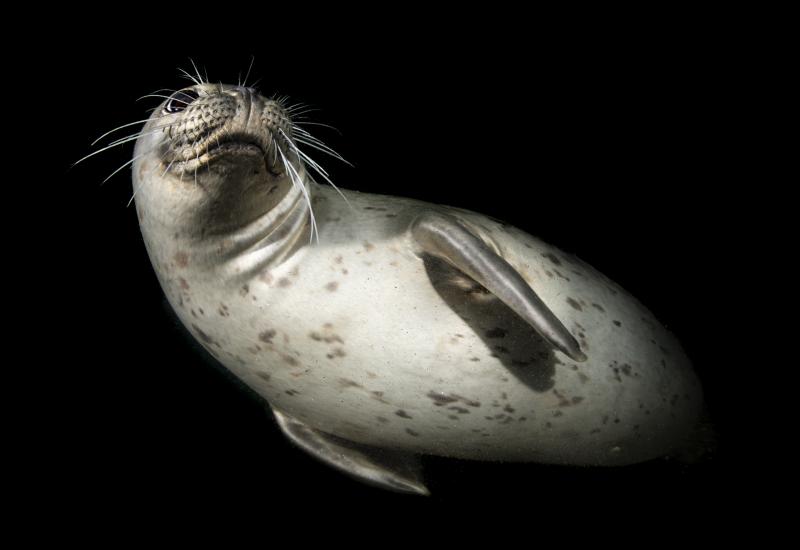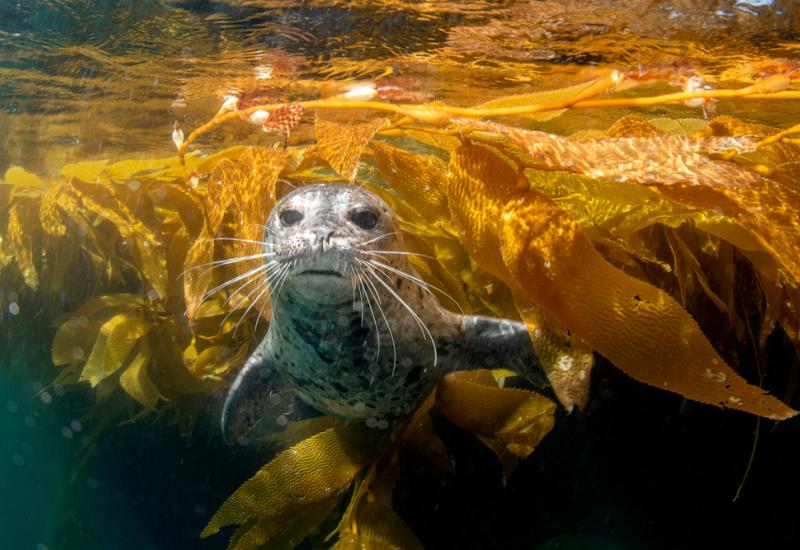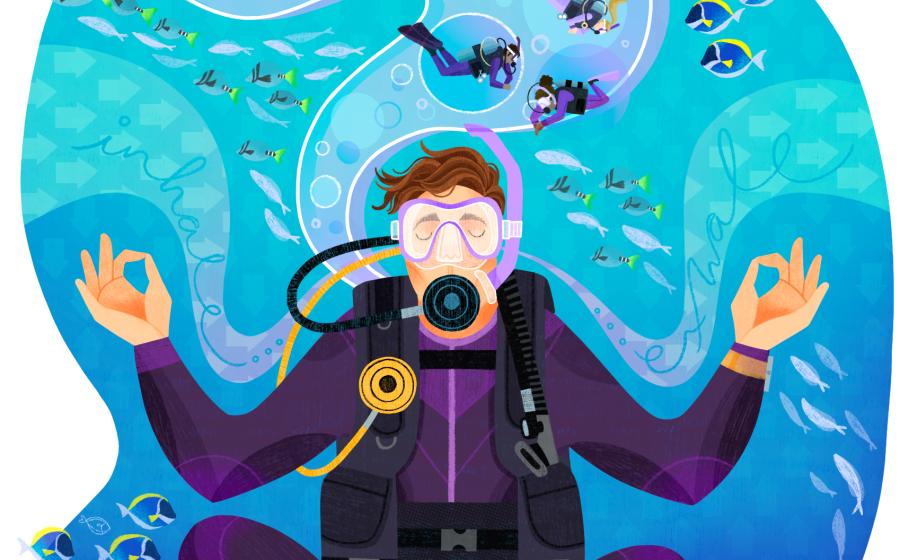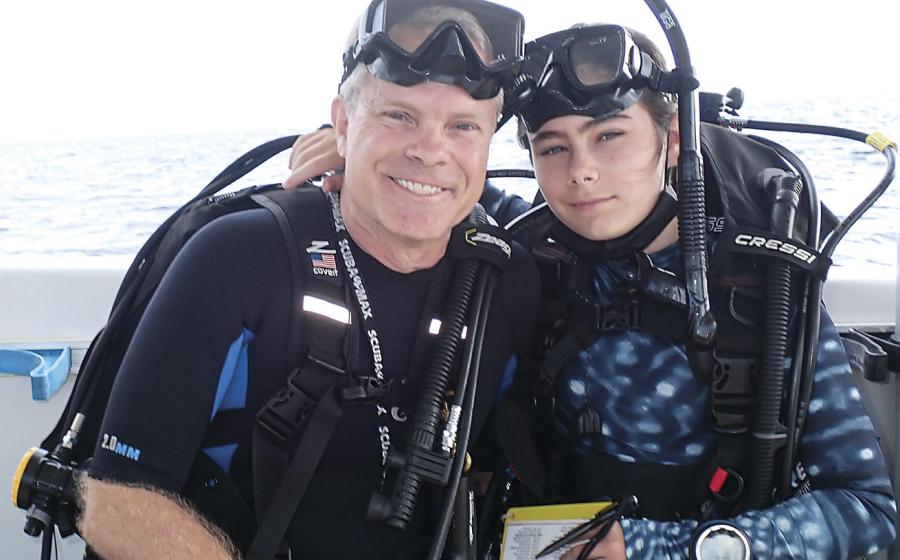Diving Southern California's Oil Rigs
The steel behemoths don’t fit the palm-fringed SoCal stereotype, but they are the stuff of dive legend. Southern California’s oil rigs blend man-made and natural in a package that combines the region’s best underwater features, creating dive sites that offer some of the best multilevel diving in the world. Rec or tec, reef lover and wreck hunter, photographer and videographer: The platforms appeal to us all.
Lure of the Deep
The boat pulls close to the huge structure, disturbing the sea lions draped lazily across the moorings and inciting a cacophony of barking protest. We’ve arrived at the Eureka oil platform, our favorite of the three diveable rigs near Long Beach. The captain shifts the boat into neutral as the divemaster calls out, “Ready? Dive!” Pairs of divers oblige, and soon it’s my turn on the swim step. As I enter the water, the butterflies in my stomach have returned. It’s a familiar sensation. Despite the hundreds of hours I’ve spent underwater here, descending under the platform still spooks me. Since the huge surface structure blocks out much of the ambient light, it takes my eyes a minute to adjust to the dark water. The lattice of giant steel beams extends into the depths, beyond my sight and far beyond recreational limits, crossing horizontally at 60-foot intervals to create a beckoning series of levels. The noise of these working structures adds to the eerie ambience, as thundering resupply boats arrive and hisses accompany bursts of bubbles that periodically emerge from the depths. I pass a thermocline that drops the temperature 8 chilly degrees as the current abruptly shifts and speeds up. I watch my gauges vigilantly. When we reach our maximum depth of 140 feet, my buddy and I level off and flash each other eager “OK” signs (his more eager than mine).
That’s when it always happens. As soon as my light illuminates the nearest crossbeams, the scary stuff falls away. If a cooler jungle gym exists, I haven’t seen it. Spellbound, I adjust my camera and choose what to photograph first.
Below 100 feet, clusters of giant metridium anemones jut from girders encrusted with brittle stars, scallops and pink corynactis, giving the otherwise burly structure a fluffy pink-and-white coat. The search is a ritual for us, beginning anew at the start of nearly every platform dive. The process takes time, requiring a slow perusal of the structure that results in the discovery of other subjects. A large lingcod pouts from a nearby girder, but he refuses to sit still for a portrait and bolts into deep water. Then I come across an incredible find: a large male cabezon guarding a multihued egg nest.
Magic in Midwater
Too soon, it’s time to begin venturing to shallower water. At most dive sites, starting an ascent sparks a minor bout of depression. Here, though, the color palette makes melancholy impossible. We bid farewell to the giant metridiums and maneuver into shallower water as the hues around us amp up. At depths of 50 to 80 feet, pink, lavender and peach-tinted corynactis share space with bright yellow sponges, purple urchins, and ochre sea stars.
The fish at these depths add to the kaleidoscope. Brightly speckled rockfishes and greenlings watch cautiously from the crossbeams. A plum-colored California scorpionfish attempts to remain incognito on a girder, despite the determined harassment of several crimson sheepheads. An orange garibaldi charges us angrily, guarding his nest. It’s a feast for photographers, and we happily partake.
Modeling patiently for my buddy, I notice he has turned to face the other direction. I grumble until I see where his attention lies: a 3-foot mola is swimming toward him.
These bizarre, disc-shaped fish are a common sight at the platforms, but they rarely approach divers closely. I look down at my own camera rig, clipped to my BC with its strobe arms folded tightly. If I make any big movements, neither of us will get close enough to photograph the sunfish. I selflessly take one for the team and sit tight.
Closer…closer…the mola is right in front of him now. I groan into my regulator as the lucky shutterbug fires off a series of shots. The shocked mola swims swiftly away, and my buddy turns back to me victoriously. I point at him, attempting to communicate the first thought that pops into my head: “You owe me!”
The Ultimate Safety Stop
We continue our ascent through a swirl of silvery baitfish, watching as the scenery changes once again. At depths of less than 40 feet, the girders are encrusted with glossy black mussels and small white colonial anemones, less remarkable than the technicolor array encasing the deeper structures. Frankly, I find the backdrop more exciting, since the shallow water here in the open ocean is often filled with a parade of glowing pelagic invertebrates. Salp chains, graceful sea butterflies, and pulsing comb jellies: What better way to pass a safety stop?
I shoot until my index finger aches, but something’s not quite right. I can’t shake the feeling that I’m being watched, and I keep turning to see what’s behind me. Seconds pass slowly before I spot the culprit. A dark shape buzzes me repeatedly. Finally, my follower approaches me head on. I am being stalked, no doubt about it, and my admirer is a beauty.
With her silvery coat, she’s lighter than most of the other sea lions in her small group. As I observe her closely, I realize she’s being tailed by a tiny pup that is trying to nurse. The rest of my stop passes quickly as I photograph the rare poignant scene. Eventually the sea lion swims away, and I surface, euphoric, and signal to the boat. As I am climbing on board, I hear shouts from the divers on board.
“Whale!”
I turn to see a massive shape in the water. I look at my buddy and instantly know exactly what he’s thinking. Grey whales, far more common in these parts, aren’t this big — this giant is a blue whale. The huge creature hesitates briefly at the surface, filling its lungs before it dives. I instantly recall what I have heard captains say many times: Divers can see almost anything at the oil platforms.
On the way home, the sun-drenched deck is crowded with elated divers comparing tales, examining photographs and watching the horizon for whales. When we’re finally tied at the dock, the captain walks past. Before I can even voice my request, he winks.
“Don’t worry. I already added you guys for the next charter. See you Saturday.”
What It Takes
The Long Beach oil platforms visited most commonly (Eureka, Ellen and Elly) are considered advanced dives due to unpredictability of conditions and “bottomless” structure (Eureka lies in 700 feet of water while Ellen and Elly plunge to depths of 260 feet). Divers must have excellent buoyancy control and be comfortable performing free descents and ascents in open ocean. It is critical to remain aware of depth, air consumption, and NDL or decompression obligations. Compasses are useless underneath these massive steel structures. Large surface signaling devices are a necessity.
All diving is done by live drop and pickup, as boats cannot tie off to the platforms and anchoring in these depths is impractical. Boats must call ahead to gain permission for divers to enter the water, so it is best to join an arranged charter. These sites are working platforms with active resupply boat traffic; divers must pay close attention to briefings detailing entry, descent, surfacing, and getting back to the dive boat.
Need to Know
When to Go: While conditions in open ocean are never predictable, the best chance at optimum visibility is between July and December.
Dive Conditions: Temperatures at depth can range from the low 50s in late spring to low 60s in the autumn. A drysuit or 7 mm wetsuit with hooded vest, boots and gloves is recommended year-round. Visibility can vary widely, ranging from less than 10 feet to well over 100. Surge is a given, and currents can occasionally be strong or rapidly changing.
Dive Operators: Getaway Charters and Adventures (310-714-0548) offers trips to the oil platforms out of San Pedro, California; air and nitrox fills are available on board. Pacific Star Diving (www.pacificstardiving.com) also runs regular trips to the rigs out of San Pedro, California; air and nitrox fills are available on board. Selky Charters (selkycharters.com), is a six-pack boat that operates out of Huntington Beach, California. There is no compressor on board; however, steel tanks containing air or nitrox can be prearranged with the crew.
Price Tag: Prices for a three-tank dive trip to the Long Beach oil platforms range from $100 to $150 per person.
Like advanced scuba diving? Visit the Advanced Adventures section of our website.
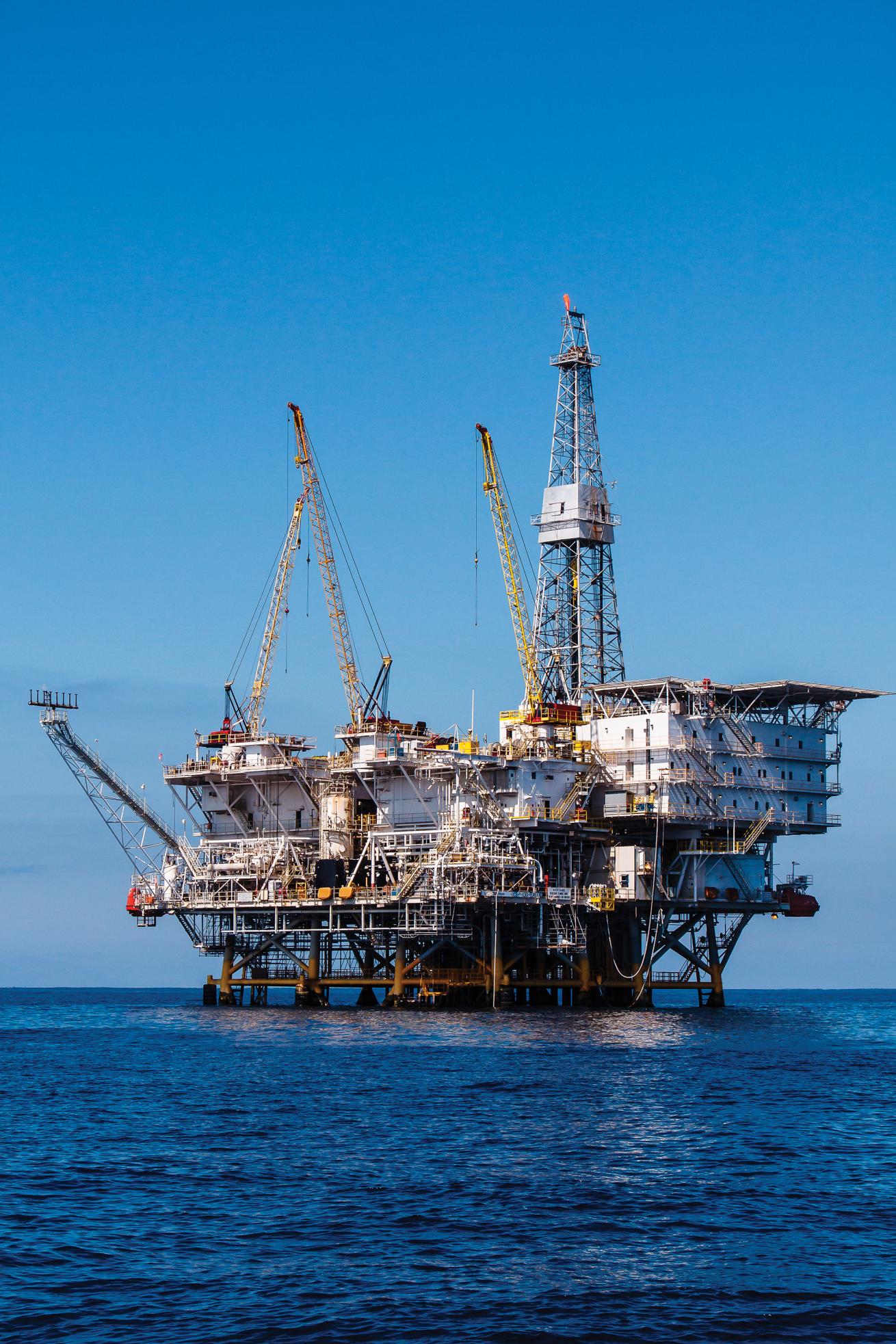
Allison and Andy SallmonThe Eureka platform sits off shore from the Los Angeles area, and is the deepest rig accessible to divers.
The steel behemoths don’t fit the palm-fringed SoCal stereotype, but they are the stuff of dive legend. Southern California’s oil rigs blend man-made and natural in a package that combines the region’s best underwater features, creating dive sites that offer some of the best multilevel diving in the world. Rec or tec, reef lover and wreck hunter, photographer and videographer: The platforms appeal to us all.
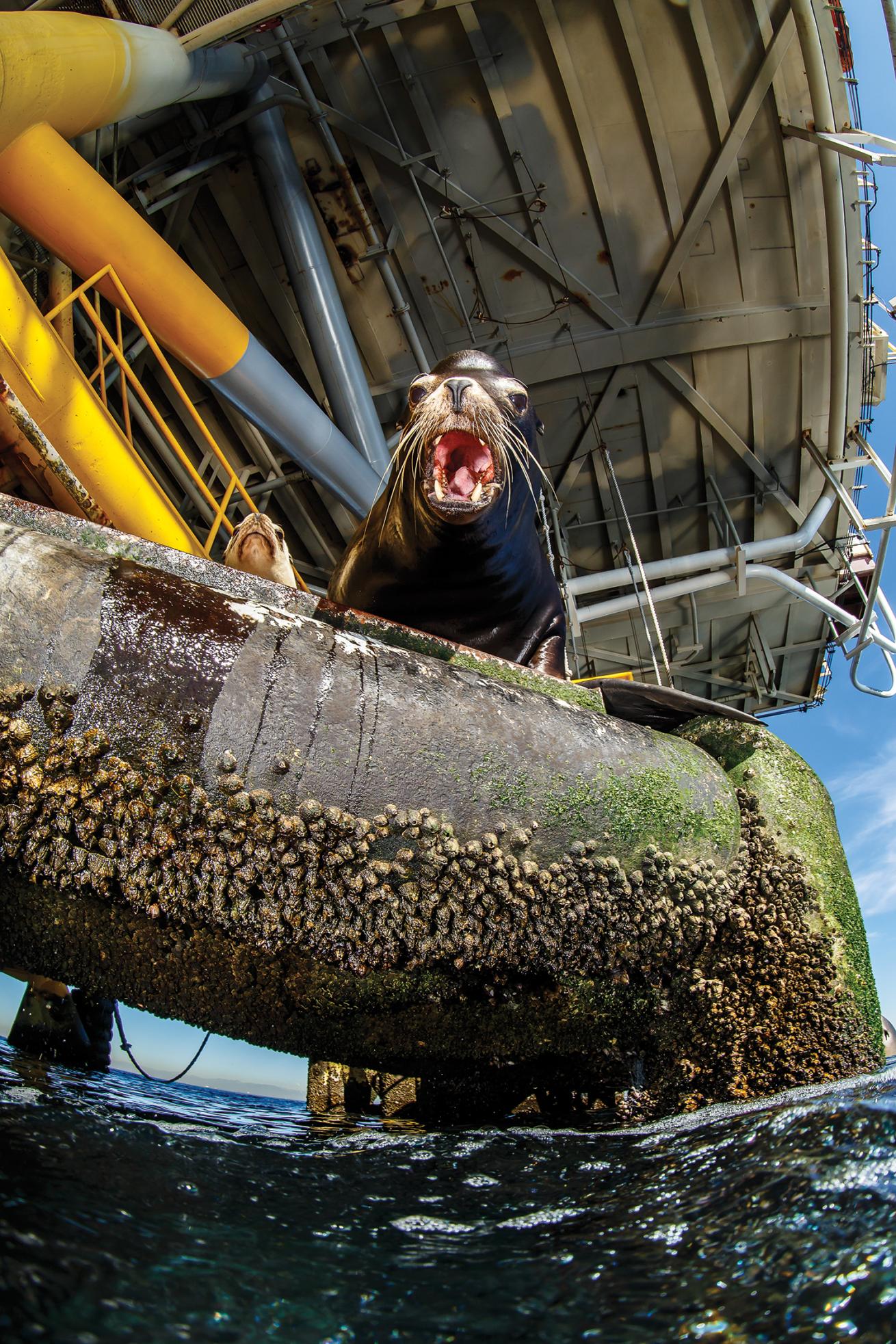
Allison and Andy SallmonA sea lion aboard one of the oil rigs disapproves of intruding divers.
Lure of the Deep
The boat pulls close to the huge structure, disturbing the sea lions draped lazily across the moorings and inciting a cacophony of barking protest. We’ve arrived at the Eureka oil platform, our favorite of the three diveable rigs near Long Beach. The captain shifts the boat into neutral as the divemaster calls out, “Ready? Dive!” Pairs of divers oblige, and soon it’s my turn on the swim step. As I enter the water, the butterflies in my stomach have returned. It’s a familiar sensation. Despite the hundreds of hours I’ve spent underwater here, descending under the platform still spooks me. Since the huge surface structure blocks out much of the ambient light, it takes my eyes a minute to adjust to the dark water. The lattice of giant steel beams extends into the depths, beyond my sight and far beyond recreational limits, crossing horizontally at 60-foot intervals to create a beckoning series of levels. The noise of these working structures adds to the eerie ambience, as thundering resupply boats arrive and hisses accompany bursts of bubbles that periodically emerge from the depths. I pass a thermocline that drops the temperature 8 chilly degrees as the current abruptly shifts and speeds up. I watch my gauges vigilantly. When we reach our maximum depth of 140 feet, my buddy and I level off and flash each other eager “OK” signs (his more eager than mine).
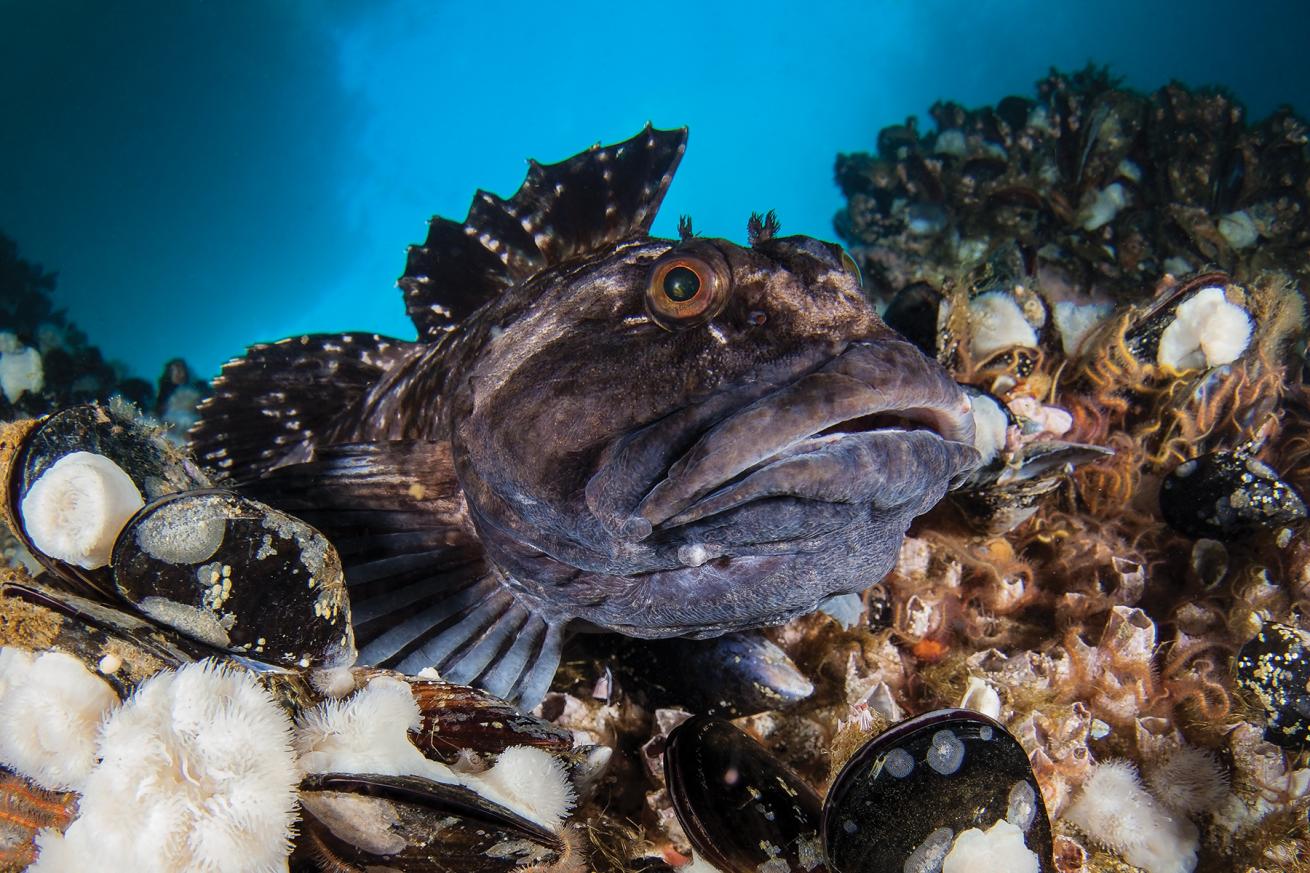
Allison and Andy SallmonCabezon, native to the Pacific coast of North America, find homes in the shallow waters surrounding the oil rigs. Cabezon are frequently found in kelp beds from shallow to moderate depths.
That’s when it always happens. As soon as my light illuminates the nearest crossbeams, the scary stuff falls away. If a cooler jungle gym exists, I haven’t seen it. Spellbound, I adjust my camera and choose what to photograph first.
Below 100 feet, clusters of giant metridium anemones jut from girders encrusted with brittle stars, scallops and pink corynactis, giving the otherwise burly structure a fluffy pink-and-white coat. The search is a ritual for us, beginning anew at the start of nearly every platform dive. The process takes time, requiring a slow perusal of the structure that results in the discovery of other subjects. A large lingcod pouts from a nearby girder, but he refuses to sit still for a portrait and bolts into deep water. Then I come across an incredible find: a large male cabezon guarding a multihued egg nest.

Allison and Andy SallmonMussels, starfish barnacles and anemones proliferate in the shallowest levels of the oil rig waters.
Magic in Midwater
Too soon, it’s time to begin venturing to shallower water. At most dive sites, starting an ascent sparks a minor bout of depression. Here, though, the color palette makes melancholy impossible. We bid farewell to the giant metridiums and maneuver into shallower water as the hues around us amp up. At depths of 50 to 80 feet, pink, lavender and peach-tinted corynactis share space with bright yellow sponges, purple urchins, and ochre sea stars.
The fish at these depths add to the kaleidoscope. Brightly speckled rockfishes and greenlings watch cautiously from the crossbeams. A plum-colored California scorpionfish attempts to remain incognito on a girder, despite the determined harassment of several crimson sheepheads. An orange garibaldi charges us angrily, guarding his nest. It’s a feast for photographers, and we happily partake.
Modeling patiently for my buddy, I notice he has turned to face the other direction. I grumble until I see where his attention lies: a 3-foot mola is swimming toward him.
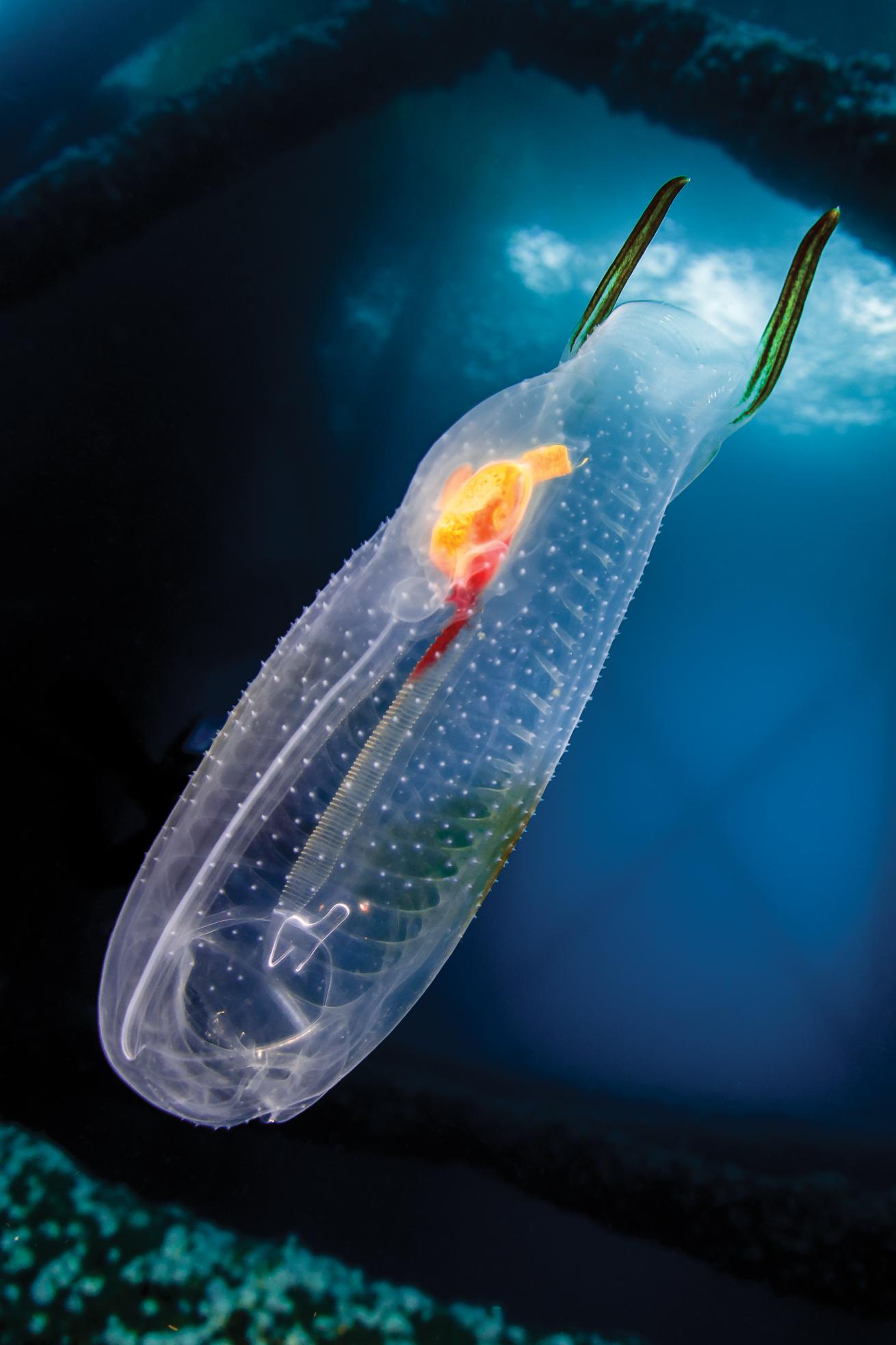
Allison and Andy SallmonPelagic invertebrates are abundant around the oil rigs off southern California's coast.
These bizarre, disc-shaped fish are a common sight at the platforms, but they rarely approach divers closely. I look down at my own camera rig, clipped to my BC with its strobe arms folded tightly. If I make any big movements, neither of us will get close enough to photograph the sunfish. I selflessly take one for the team and sit tight.
Closer…closer…the mola is right in front of him now. I groan into my regulator as the lucky shutterbug fires off a series of shots. The shocked mola swims swiftly away, and my buddy turns back to me victoriously. I point at him, attempting to communicate the first thought that pops into my head: “You owe me!”

Allison and Andy SallmonGaribaldi is the official marine state fish of California and is protected in California coastal waters. During egg hatching, male Garibaldi aggressively guard the nest from potential predators and will boldly attack much larger creatures, including humans, to drive them away from the area where the eggs are.
The Ultimate Safety Stop
We continue our ascent through a swirl of silvery baitfish, watching as the scenery changes once again. At depths of less than 40 feet, the girders are encrusted with glossy black mussels and small white colonial anemones, less remarkable than the technicolor array encasing the deeper structures. Frankly, I find the backdrop more exciting, since the shallow water here in the open ocean is often filled with a parade of glowing pelagic invertebrates. Salp chains, graceful sea butterflies, and pulsing comb jellies: What better way to pass a safety stop?
I shoot until my index finger aches, but something’s not quite right. I can’t shake the feeling that I’m being watched, and I keep turning to see what’s behind me. Seconds pass slowly before I spot the culprit. A dark shape buzzes me repeatedly. Finally, my follower approaches me head on. I am being stalked, no doubt about it, and my admirer is a beauty.
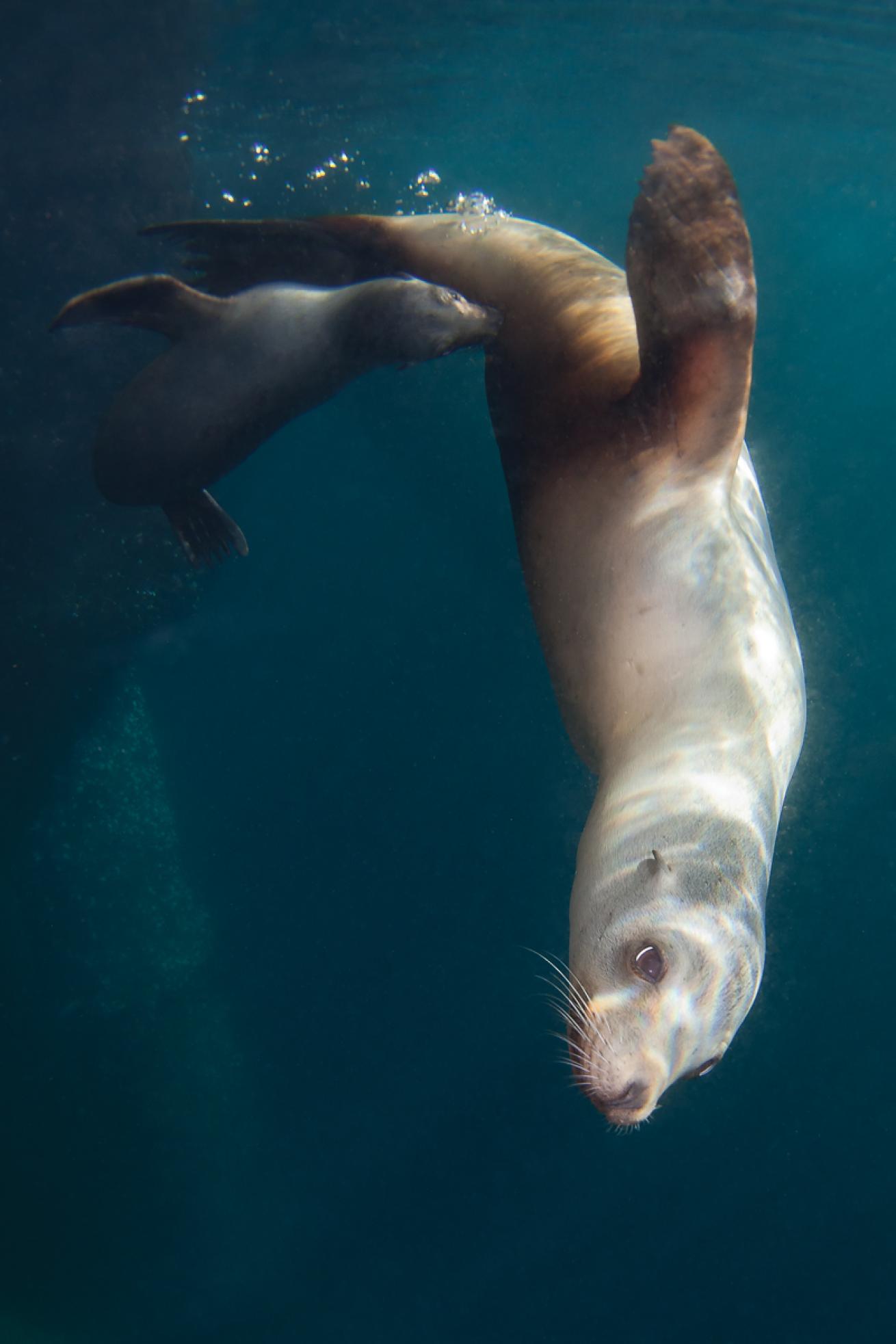
Allison and Andy SallmonA sea lion nurses her playful pup in the shallow waters adjacent to the Eureka oil platform. Eureka is the deepest of the California platforms accessible to divers.
With her silvery coat, she’s lighter than most of the other sea lions in her small group. As I observe her closely, I realize she’s being tailed by a tiny pup that is trying to nurse. The rest of my stop passes quickly as I photograph the rare poignant scene. Eventually the sea lion swims away, and I surface, euphoric, and signal to the boat. As I am climbing on board, I hear shouts from the divers on board.
“Whale!”
I turn to see a massive shape in the water. I look at my buddy and instantly know exactly what he’s thinking. Grey whales, far more common in these parts, aren’t this big — this giant is a blue whale. The huge creature hesitates briefly at the surface, filling its lungs before it dives. I instantly recall what I have heard captains say many times: Divers can see almost anything at the oil platforms.
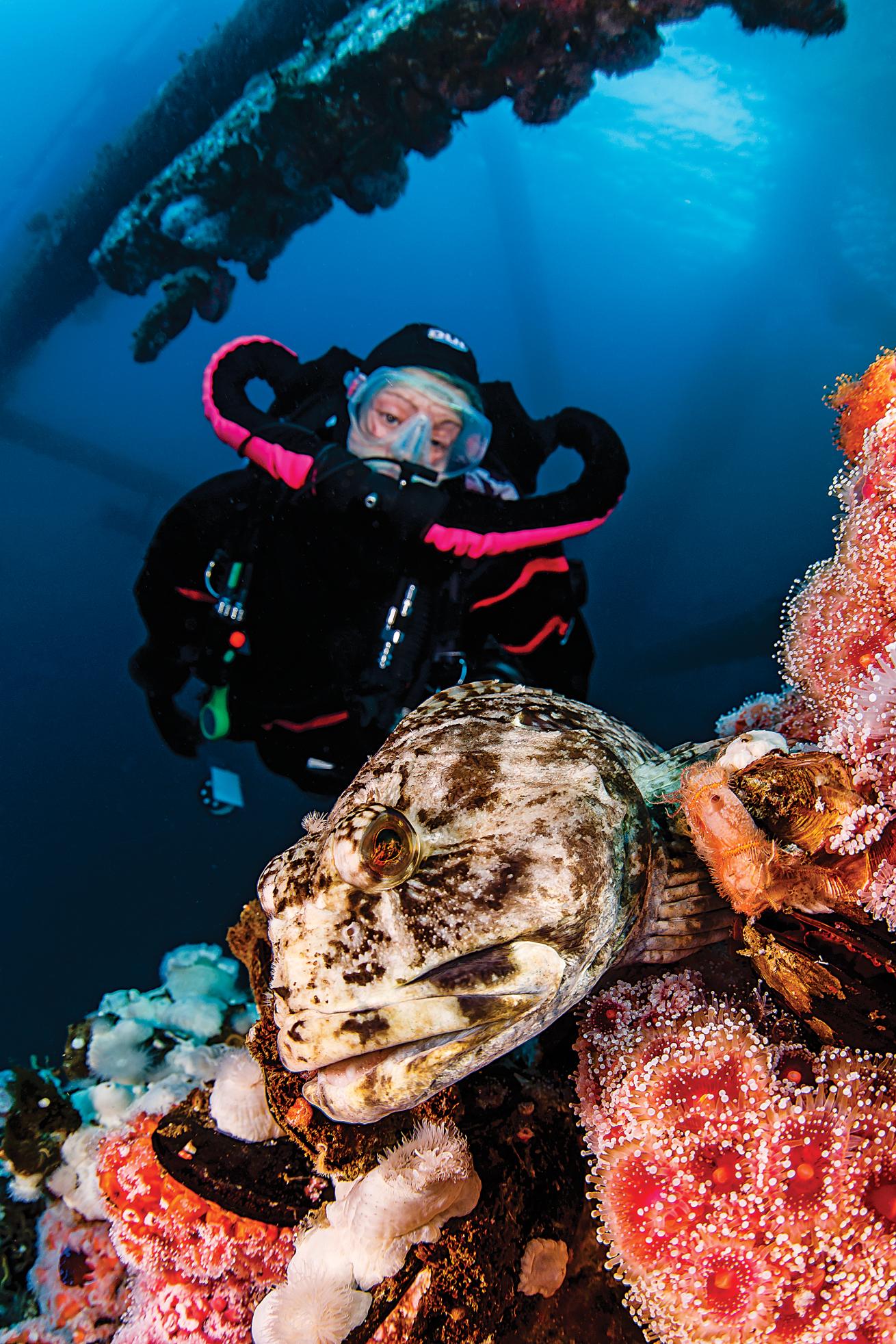
Allison and Andy SallmonCalifornia's aptly named Eureka platform supports a host of wonders like this cabezon.
On the way home, the sun-drenched deck is crowded with elated divers comparing tales, examining photographs and watching the horizon for whales. When we’re finally tied at the dock, the captain walks past. Before I can even voice my request, he winks.
“Don’t worry. I already added you guys for the next charter. See you Saturday.”
What It Takes
The Long Beach oil platforms visited most commonly (Eureka, Ellen and Elly) are considered advanced dives due to unpredictability of conditions and “bottomless” structure (Eureka lies in 700 feet of water while Ellen and Elly plunge to depths of 260 feet). Divers must have excellent buoyancy control and be comfortable performing free descents and ascents in open ocean. It is critical to remain aware of depth, air consumption, and NDL or decompression obligations. Compasses are useless underneath these massive steel structures. Large surface signaling devices are a necessity.
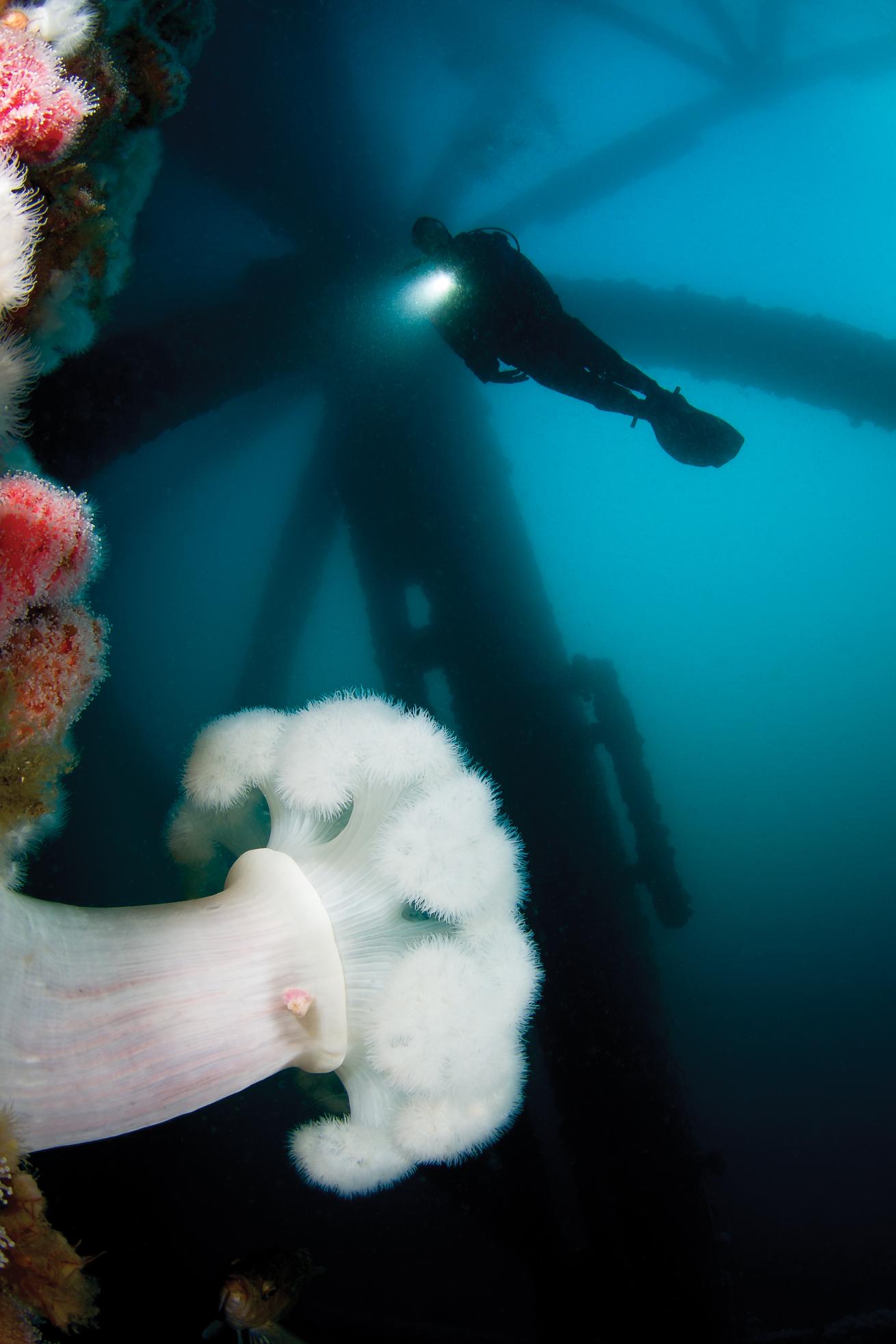
Allison and Andy SallmonGiant metridium are plentiful on the deep structures of the oil platforms. These sea anemones are found mainly in the cool waters of the northern Pacific and Atlantic oceans.
All diving is done by live drop and pickup, as boats cannot tie off to the platforms and anchoring in these depths is impractical. Boats must call ahead to gain permission for divers to enter the water, so it is best to join an arranged charter. These sites are working platforms with active resupply boat traffic; divers must pay close attention to briefings detailing entry, descent, surfacing, and getting back to the dive boat.

Allison and Andy SallmonBold colors are found everywhere around the oil platforms, especially in pilings.
Need to Know
When to Go: While conditions in open ocean are never predictable, the best chance at optimum visibility is between July and December.
Dive Conditions: Temperatures at depth can range from the low 50s in late spring to low 60s in the autumn. A drysuit or 7 mm wetsuit with hooded vest, boots and gloves is recommended year-round. Visibility can vary widely, ranging from less than 10 feet to well over 100. Surge is a given, and currents can occasionally be strong or rapidly changing.
Dive Operators: Getaway Charters and Adventures (310-714-0548) offers trips to the oil platforms out of San Pedro, California; air and nitrox fills are available on board. Pacific Star Diving (www.pacificstardiving.com) also runs regular trips to the rigs out of San Pedro, California; air and nitrox fills are available on board. Selky Charters (selkycharters.com), is a six-pack boat that operates out of Huntington Beach, California. There is no compressor on board; however, steel tanks containing air or nitrox can be prearranged with the crew.
Price Tag: Prices for a three-tank dive trip to the Long Beach oil platforms range from $100 to $150 per person.
Like advanced scuba diving? Visit the Advanced Adventures section of our website.

